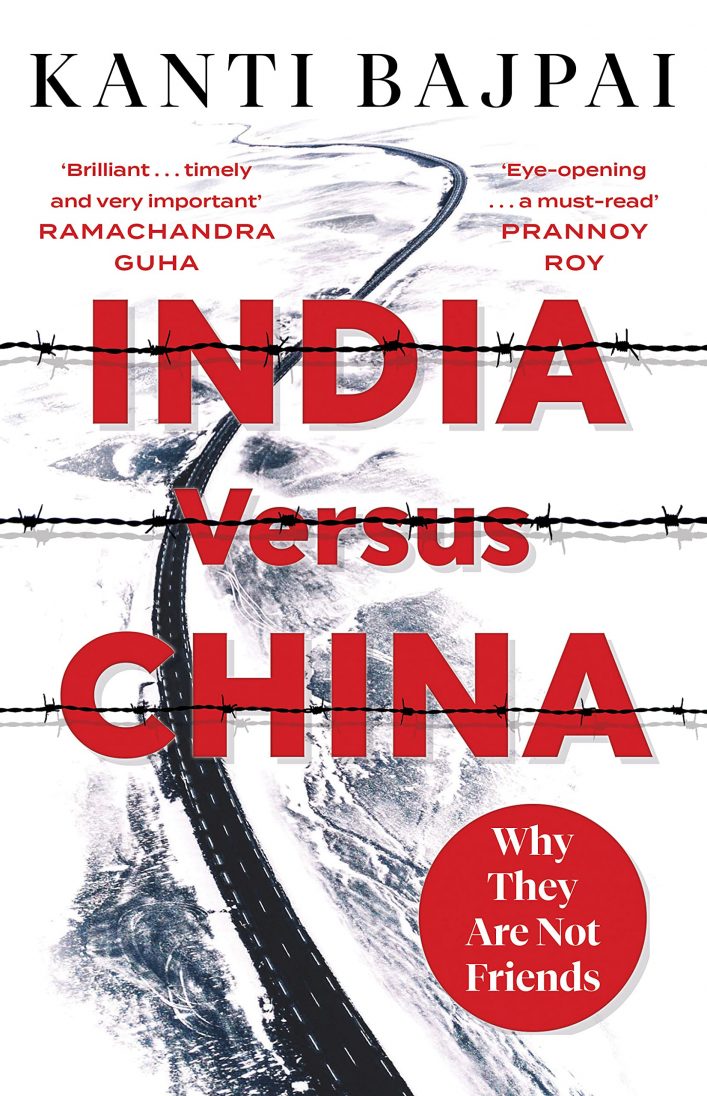Book Review: India Versus China: Why They Are Not Friends

Conflict along the Sino-Indian border has brought home for India the reality of dealing with a powerful neighbor. An unintended side effect has been the course correction in Indian public discourse of the erstwhile neglect of Chinese politics and foreign policy.
Kanti Bajpai’s India Versus China: Why They Are Not Friends locates the recent clashes in the longue durée context of Sino-Indian antagonism, as the subtitle lays it bare. Bajpai may be one of the sharpest scholars of Indian grand strategy, but India Versus China is meant for a general audience. The narrative fluidity, though, in no way takes away the scholarly erudition.
For Bajpai, the primary factors undergirding the marked deepening of Sino-Indian antagonism are fourfold. Bajpai identifies “four Ps” responsible for one of the most significant Asian geopolitical power rivalries in the 21st century: perception, perimeter, partnership, and power. Based largely on secondary sources, Bajpai does a good job of dealing with the historical evolution of Sino-Indian ties across these parameters. However, his insights on the contemporary contours and future evolution of the antagonistic relationship should be more relevant for readers and policymakers.
A Fractious Relationship
The mutual perception of India and China towards each other, as Bajpai shows using quantitative and qualitative sources, leaves much to be desired. The lack of a shared sense of admiration and trust among both policy elites and the general populace makes it much more challenging to take a reconciliatory or concessional approach in managing the relationship. While Indians have come to develop a sense of fearful admiration for China’s rise, the Chinese perception of India is characterised by nonchalance over India’s relative unimportance as a lesser power encumbered by chaos and poverty. These less-than-positive perceptions are further buttressed by media-promoted jingoism and plebeian racism on both sides of the border. Further, Bajpai convincingly argues that the dominant strategic worldviews in both India (Kautilyan and Great Power) and China (Tianxia, Great Power, and Communist) do not lend much hope for a bilateral relationship premised on equal footing.
The perimeter aspect of Sino-Indian contestation relates to the border dispute and the status of Tibet. Bajpai meticulously traces both the outbreak of border conflicts and the evolution of conflict resolution mechanisms since the late 1940s. The bilateral relationship has been shaped by the colonial legacy of the unsettled border. The importance of Tibet to both India and China in maintaining security has also contributed to the entangled relationship. For China, the border conflict with India and the vexed issue of Tibetan integration are interlinked, and control over the border is crucial to control over the Tibetan Autonomous Region. On the other hand, India considers Tibetan autonomy instrumental in minimising the Chinese military presence near its largely inhospitable border, which cannot be administered as easily as the mainland.
In terms of strategic partnership, India and China more often than not ended up on opposite sides during the Cold War. While the Chinese threat drove India’s strategic alignment, India did not figure prominently in China’s strategic partnership calculations. After the Cold War, the US unipolarity merited a brief period of soft balancing from Russia, China, and India. With China’s rise, India and the US are drawing closer while Russia drifts towards China. The Cold War logic of oppositional camps for India and China once again seems to be in the offing.
Finally, the most consequential element in the Sino-Indian relationship is the power differential. Bajpai categorises the sinews of power in terms of economic, military, and soft power. A thorough bean-counting exercise across these three spectrums leads him to conclude that China is an adversary seven times as powerful as India. While differences in economic power are vast, the military power differential is tempered by geography, as the Himalayas in the north and the vast stretch of the Indian Ocean in the south blunt Chinese power projection and even provide India advantages in some theatres. It is ultimately strategy and logistics that shall count the most in case of a limited war, argues Bajpai.
India’s Future Options
While most Indian strategic elites see the coming world order to be a multipolar one, Bajpai clearly sees a bipolar order in the making. India’s options in this arrangement remain twofold. In the near term, it must indulge in what scholars call external balancing by relying on the US to tackle the Chinese threat to its interests. Bajpai envisages the extent of the US help in terms of intelligence sharing, arms provision, military technology procurement, and diplomatic support. Envisaged as a primer on the Sino-Indian rivalry, the book stops short of considering avenues of cooperation between India and China on matters of shared interest, particularly on climate change and in global governance forums .
The long-term solution for India to meet the China challenge is to be a great power itself. Bajpai argues that India needs a fundamental, whole-of-society overhaul and rejection of traditional mores to achieve the transformation that has primarily been an elite and middle-class preoccupation. No nation can be prosperous and wield economic and military power with so many stunted children, unemployed youths, and oppressed women. In the author’s telling, the fundamental break ought to be akin to communist revolutions in Asia, which, per economist Branko Milanovic, swept away feudal order and paved the way for indigenous capitalism.
However, India’s raucous democracy with active interest group participation makes it challenging to bring radical change. The dominant strain in Indian politics has been the centrist tendency of moderation and gradualism, which has translated into the persistence of the traditional power structure and customs. Nevertheless, India since the 1990s has seen rapid transformation, and several factors portend well for the continuation of this trend. Cliched as it may seem, India is definitely undergoing a massive churn enabled by forces of modernity with attendant geopolitical and balance of power implications as well. While some of it augurs well, there also exists cause for worry.
In particular, social divisiveness based on exclusivist tribalism in domestic politics translates into unfavorable repercussions for foreign policy as well. The entrenchment of a solid and discriminatory in-group identity in domestic politics undergirded by zero-sum logic harms national interest by foregoing gains from cooperation. The implication for India is not hard to see. With the consolidation of the fourth party system under a Hindu majoritarian government, the Indian state and the Hindu society have increasingly turned hostile to India’s Muslim minority. The bid to demonise and alienate a significant section of Indians would only undermine social cohesiveness with consequent deleterious implications for national power.
To be sure, the Hindutva project has not adversely impacted India’s foreign policy engagement with Muslim-majority Gulf countries. In fact, those ties have gone from strength to strength in recent times. However, insofar as the majoritarian thrust is linked to India’s democratic backsliding, the concern in the West over India’s illiberal turn would cause unnecessary friction in the strategic partnership against China.
In conclusion, both the self-positioning and recognition by others of India as a leading global power show the potential that India holds as a challenger to China and a pivotal power in the international system. India Versus China: Why They are Not Friends does a good job of tracing one of the most consequential foreign relations for an India which aspires to lead the world as a pole. In order for that potential to materialise, though, India needs to go a long way, and the recent trends present a mixed picture at best.
This is a review of Kanti Bajpai, India Versus China: Why They Are Not Friends (Juggernaut, 2021). ISBN: 9391165087.
Sanjeet Kashyap is a final year MA student in Politics and International Studies program at Jawaharlal Nehru University, New Delhi. Twitter: @sanjeet38.
This article is published under a Creative Commons License and may be republished with attribution.





